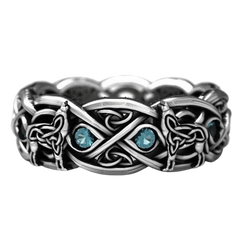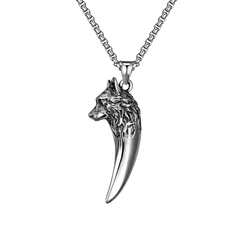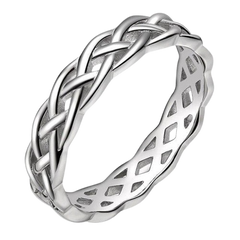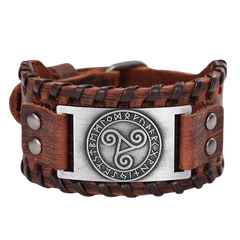Meanings and Origins of Celtic Symbols
- min of reading
Summary :

Nordic Wolf Celtic Ring
£25.70

Wolf Head Necklace
£25.70

Celtic Entwined Ring
£29.18

Celtic Triskel Bracelet
£25.70

Viking Rune Ring
£29.18
The Celts have always been fascinated by what they have observed in nature, it is from this fascination that Celtic symbols were born.
Indeed, like many ancient symbols, Celtic symbols are inspired by shapes found in nature; the swell of waves, the undulations of flames and the shapes of plants are the primary inspiration for many Celtic symbols .
The oldest Celtic symbols have been discovered on carvings dating back more than 10,000 years. The first of these to be created were simple symbols such as spirals and then these patterns evolved into more complex symbols such as the triquetra and the interlacing .
If you love Celtic symbols and jewelry then you are in the right place, our shop offers high quality handmade Celtic jewelry .
The spiral
The spiral is one of the first Celtic symbols , the Celts would have designed this symbol by observing nature, the movement of waves, the undulations of flames and perhaps even the rotations of the stars present in the sky.
The spiral represents the energy of the universe, constant change, an infinite symbol without beginning or end. Many spirals have been found on funerary monuments, which is why it is thought that it also represents reincarnation and the continuity of life through the spirit, which never dies.
Reincarnation is a concept that is very present among the Celts, and can be found in the meaning of many other symbols.
The interlacing
The knotwork , an intricate and fascinating pattern found in many Celtic symbols, embodies the richness and depth of Celtic culture . This knotwork pattern, also known as the Celtic knot, is characterized by its intertwined lines without beginning or end, representing the eternal interconnectedness of all elements of life. Each curve and loop of the knotwork symbolizes the unity between the physical and the spiritual, the past and the present, and the different facets of human existence. The ancient Celts used these patterns in their art, crafts, and religious symbols to express concepts such as eternity, continuity, and harmony with nature. Today, the knotwork continues to hold a fascination, inspiring artists, designers, and spiritual seekers around the world. Its legacy lives on in a multitude of contemporary interpretations, from exquisite Celtic jewelry to elaborate tattoos, testifying to its timeless meaning and evocative power.
The triquetra
The triquetra or also called triquetra is certainly one of the most famous Celtic symbols in the world, also called the trinity knot by Christians, it is the source of many stories and legends.
The triquetra, at first glance looks like a triangle but in reality it is a knot formed of three loops, each of which joins to form three points. In ancient Celtic culture, the triquetra symbolized the cohesion between the three aspects of man, the body, the soul and the spirit. Later, Christianity renamed the triquetra the knot of the Trinity, where it represented the father, the son and the holy spirit.

The Celtic Cross
The Celtic cross , a symbol loaded with history and meaning, embodies the fusion between Celtic spirituality and Christianity. Recognizable by its circle surrounding the junction of the arms, the Celtic cross represents the union between the divine and the earthly, as well as the balance between the sacred and the profane.
For the Celts , this symbol was of paramount importance, being associated with religious rituals, funerary customs and artistic expressions. Although its exact origin remains a matter of debate, the Celtic cross is widely interpreted as an emblem of protection, strength and connection with the cycles of nature.
Today, she continues to inspire a wide range of people around the world, whether they are passionate about Celtic culture, spirituality or simply drawn to her elegant and timeless aesthetic.
The triskel
The triskelion , a distinctive Celtic symbol with three intertwined branches, has attracted interest for centuries for its rich and evocative symbolism. Originating from ancient Celtic culture, this motif embodies the notion of perpetual motion and the connection between time cycles.
The three branches of the triskelion often symbolize concepts such as earth, sea and sky, or body, soul and spirit, reflecting the holistic vision of the Celts. Beyond its spiritual significance, the triskelion is also associated with practical aspects of life, such as luck, protection and harmony.
Its dynamic appearance has inspired a multitude of artistic interpretations throughout the ages, illustrating its enduring role in Celtic culture and its appeal to a wide audience, whether through jewelry, decorative works or tattoos.
The tree of life
Trees often have a special meaning among early humans, and trees are found in many symbols belonging to different cultures.
Men greatly respected these imposing trees which had sometimes been there for several centuries. In many cultures, trees represent wisdom and protection . The Celts also have a tree as a symbol, they call it the tree of life .
The tree of life among the Celts is not an ordinary symbol, it is the Celtic symbol with the most importance, in fact it combines all the meanings of the other symbols, it represents the divine, protection , wisdom , luck , the cycle of the life of men from birth to death. The trees among the Celts represented the connection between the earth and the sky which they associated with the connection between life and death.
The Awen
The Awen is a Celtic symbol less known than the others but nevertheless its importance within Celtic society is not negligible.
Represented by three points on which three rays converge. In ancient Celtic language Awen means enlightenment, this symbol serves as a balance between good and evil. The Awen was mainly used by the Druids during ancient pagan rituals.

The Claddagh
Claddagh is the name of a ring created in the 16th century that symbolizes friendship and infinite love. This ring was very popular in Ireland in the 17th century and is still a symbol of Irish culture today.
The story of this ring is very particular. It begins in the Middle East where a man named Richard Joyle, a native of Claway, was captured by Algerian slave traders and sold to a jeweler.
Richard will therefore become a slave and then the goal he had set for himself, that of setting up a business in the Middle East, is now nothing more than a dream. He counted heavily on this business which would have allowed him to finance his marriage in Ireland. It was only 14 years later, while Richard was still a prisoner, that William III of England decreed that all British slaves should be freed, so Richard had to choose between two possibilities: on one hand, the Algerian jeweler offered him to stay in exchange for a sum of money and the hand of his daughter and on the other, the possibility of joining his wife.
Richard will choose to join his wife in Ireland at Claway where he will offer her a Claddagh ring that he imagined himself during his 14 years of captivity. This is how the Claddagh ring became a Celtic symbol of infinite love and fidelity.
Celtic Symbols Today
-
Tattoos
Celtic symbols are heavily represented in the form of tattoos; tattoos can be seen as a kind of substitute for the runes that the Celts used to benefit from the protective effects of Celtic symbols.
-
The jewels
Jewelry is also a way of perpetuating ancient Celtic traditions, which is why you will find high-quality handmade Celtic jewelry in our store that faithfully respects ancient Celtic symbols as closely as possible.









































